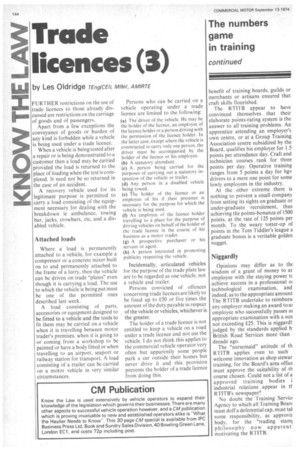Trade licences (3)
Page 154

If you've noticed an error in this article please click here to report it so we can fix it.
by Les Oldridge TEng(CEI), MIMI, AMIRTE FURTHER restrictions on the use of trade licences to those already discussed are restrictions on the carriage of goods and of passengers.
Apart from a few exceptions the conveyance of goods or burden of any kind is forbidden while a vehicle is being used under a trade licence.
When a vehicle is being tested after a repair or is being demonstrated to a customer then a load may be carried provided the load is returned to the place of loading when the test is completed. It need not be so returned in the case of an accident.
A recovery vehicle used for its legitimate purpose is permitted to carry a load consisting of the equipment necessary for dealing with the breakdown ie ambulance, towing bar, jacks, crowbars, etc, and a disabled vehicle.
Attached loads
Where a load is permanently attached to a vehicle, for example a compressor or a concrete mixer built on to and permanently attached to the frame of a lorry, then the vehicle can be driven on trade "plates" even though it is carrying a load. The use to which the vehicle is being put must be one of the permitted ones described last week.
A load consisting of parts, accessories or equipment designed to be fitted to a vehicle and the tools to fit them may be carried on a vehicle when it is travelling between motor trader's premises, when it is going to or coming from a workshop to be painted, or have a body fitted or when travelling to an airport, seaport or railway station for transport. A load consisting of a trailer can be carried on a motor vehicle in very similar circumstances. Persons who can be carried on a vehicle operating under a trade licence are limited to the following: (a) The'driver of the vehicle. He may be the holder of the licence, an employee of the licence holder or a person driving with the permission of the licence holder. In the latter case, except where the vehicle is constructed to carry only one person, the driver must be accompanied by the holder of the licence or his employee. (h) A statutory attendant.
'(c) A person being carried for the purposes of carrying out a statutory inspection of the vehicle or trailer.
(d) Any person in a disabled vehicle being towed.
(e) The holder of the licence or an employee of his if ,their presence is necessary for the purpose for which the vehicle is being used.
(f) An employee of the licence holder travelling to a place for the purpose of driving vehicles on behalf of the holder of the trade licence in the course of his business as a motor trader.
(g) A prospective purchaser or his servant or agent.
(h) A person interested in promoting publicity respecting the vehicle.
Incidentally, articulated vehicles for the purpose of the trade plate law are to be regarded as one vehicle, not a vehicle and trailer.
Persons convicted of offences concerning trade licences are likely to be fined up to £50 or five times the amount of the duty payable in respect of the vehicle or vehicles, whichever is the greater.
The holder of a trade licence is not entitled to keep a vehicle on a road under a trade licence and not use the vehicle. I do not think this applies to the commercial vehicle operator very often but apparently some people park a car outside their homes but never drive it and this provision prevents the holder of a trade licence from doing this.




























































































































































































































